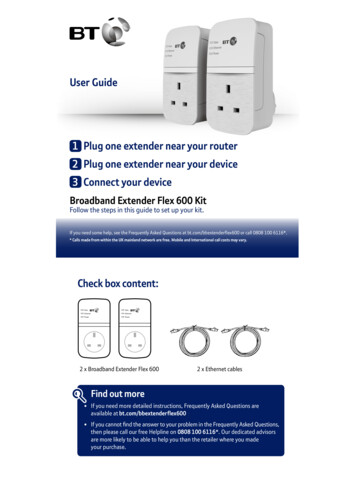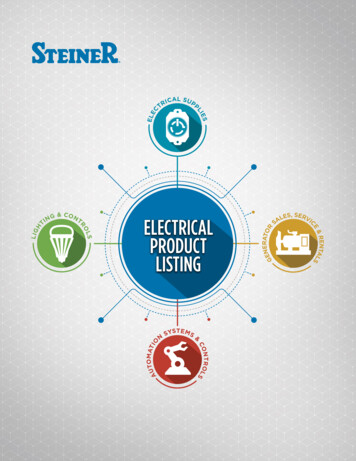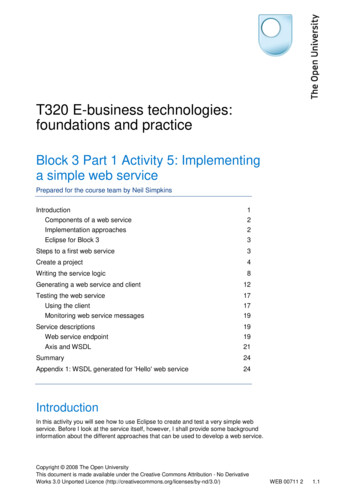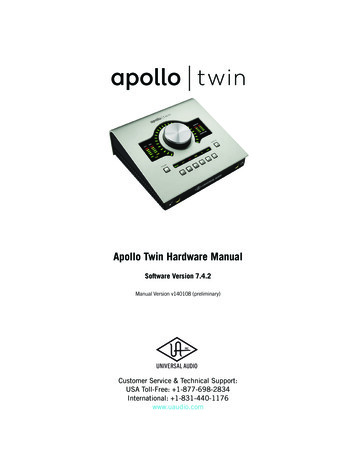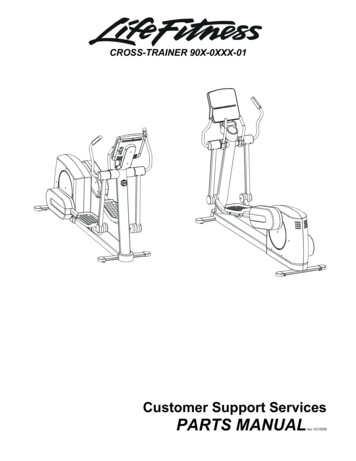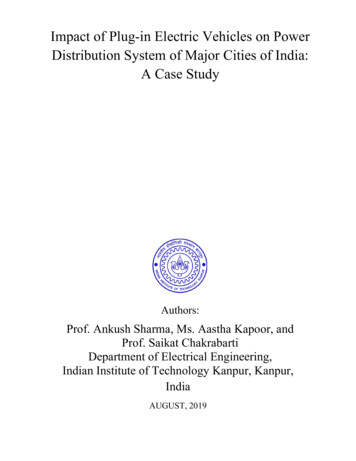
Transcription
Impact of Plug-in Electric Vehicles on PowerDistribution System of Major Cities of India:A Case StudyAuthors:Prof. Ankush Sharma, Ms. Aastha Kapoor, andProf. Saikat ChakrabartiDepartment of Electrical Engineering,Indian Institute of Technology Kanpur, Kanpur,IndiaAUGUST, 2019
DISCLAIMERThe information and opinions provided in this document are prepared by the research team ofIIT Kanpur. The team has made all efforts to collect reliable and comprehensive informationfrom various sources, such as online reports and data, in preparing this report. However, theteam does not claim that it is accurate or complete. In no event shall the research team of IITKanpur be liable for any type damages, loss in opportunity, or profit, caused by the use of thematerial or contents of this document.
ContentsList of Figures . 5Executive Summary . 81Introduction . 92Present scenario . 113Objective and Scope of the Study . 144Assumptions. 155Status of Electrical Distribution Systems of Major Cities . 195.1Delhi . 195.2Mumbai . 205.3Kolkata . 215.4Chennai . 225.5Bengaluru . 235.6Hyderabad . 246Growth Forecast for Electric Vehicles in Major Cities . 256.1Delhi . 256.2Mumbai . 286.3Kolkata . 306.4Chennai . 326.5Bengaluru . 346.6Hyderabad . 367Forecast of future distribution systems of major cities of India. 377.1Delhi . 377.2Mumbai . 447.3Kolkata . 507.4Chennai . 567.5Bengaluru . 627.6Hyderabad . 688Summary of the depth of penetration of the EV loads added to the distribution system of Indiancities . 759Conclusion . 7710Recommendations . 7911Acknowledgement . 8012References . 81
ABBREVIATIONSACAlternating CurrentBESBattery Energy StoragesBESSBattery Energy Storage SystemBEVBattery Electric VehicleDCDirect CurrentDNDistribution NetworksDTDistribution TransformerEPDSElectric power distribution systemEVElectric vehicleFAMEFaster Adoption and Manufacturing of (Hybrid &) Electric VehicleskWKilowattPEVPlug-in Electric VehiclePHEVPlug-in Hybrid Electric VehicleSLDCState Load Dispatch Centre
List of FiguresFigure 1: The different types of charging technologies (a) An ac charging station uses an onboardcharger inside an EV. (b) A dc charging station directly charges the EV battery [9] . 12Figure 2: Daily load profile of Delhi (May Month) . 19Figure 3: Daily load profile of Mumbai (May Month) . 20Figure 4: Daily load profile of Kolkata (May Month) . 21Figure 5: Daily load profile of Chennai (May Month) . 22Figure 6: Daily Load Curve for Bengaluru (May Month) . 23Figure 7: Daily load profile of Hyderabad (May Month) . 24Figure 8: Conventional load curve and total load curve, including EV, for Delhi in year 2025 – Case 1. 38Figure 9: Conventional load curve and total load curve, including EV, for Delhi in year 2030 – Case 1. 38Figure 10: Conventional load curve and total load curve, including EV, for Delhi in year 2025 – Case2 . 39Figure 11: Conventional load curve and total load curve, including EV, for Delhi in year 2030 – Case2 . 40Figure 12: Conventional load curve and total load curve, including EV, for Delhi in year 2025 – Case3 . 41Figure 13: Conventional load curve and total load curve, including EV, for Delhi in year 2030 – Case3 . 41Figure 14: Conventional load curve and total load curve, including EV, for Delhi in year 2025 – Case4 . 42Figure 15: Conventional load curve and total load curve, including EV, for Delhi in year 2030 – Case4 . 43Figure 16: Conventional load curve & total load curve, including EV, for Mumbai in year 2025 –Case 1 . 44Figure 17: Conventional load curve & total load curve, including EV, for Mumbai in year 2030 –Case 1 . 45Figure 18: Conventional load curve & total load curve, including EV, for Mumbai in year 2025 –Case 2 . 46Figure 19: Conventional load curve & total load curve, including EV, for Mumbai in year 2030 –Case 2 . 46Figure 20: Conventional load curve & total load curve, including EV, for Mumbai in year 2025 –Case 3 . 47Figure 21: Conventional load curve & total load curve, including EV, for Mumbai in year 2030 –Case 3 . 48Figure 22: Conventional load curve & total load curve, including EV, for Mumbai in year 2025 –Case 4 . 49Figure 23: Conventional load curve & total load curve, including EV, for Mumbai in year 2030 –Case 4 . 49Figure 24: Conventional load curve & total load curve, including EV, for Kolkata in year 2025 – Case1 . 50Figure 25: Conventional load curve & total load curve, including EV, for Kolkata in year 2030 – Case1 . 51Figure 26: Conventional load curve & total load curve, including EV, for Kolkata in year 2025 – Case2 . 52Figure 27: Conventional load curve & total load curve, including EV, for Kolkata in year 2030 – Case2 . 52
Figure 28: Conventional load curve & total load curve, including EV, for Kolkata in year 2025 – Case3 . 53Figure 29: Conventional load curve & total load curve, including EV, for Kolkata in year 2030 – Case3 . 54Figure 30: Conventional load curve & total load curve, including EV, for Kolkata in year 2025 – Case4 . 55Figure 31: Conventional load curve & total load curve, including EV, for Kolkata in year 2030 – Case4 . 55Figure 32: Conventional load curve & total load curve, including EV, for Chennai in year 2025 – Case1 . 56Figure 33: Conventional load curve & total load curve, including EV, for Chennai in year 2030 – Case1 . 57Figure 34: Conventional load curve & total load curve, including EV, for Chennai in year 2025 – Case2 . 58Figure 35: Conventional load curve & total load curve, including EV, for Chennai in year 2030 – Case2 . 58Figure 36: Conventional load curve & total load curve, including EV, for Chennai in year 2025 – Case3 . 59Figure 37: Conventional load curve & total load curve, including EV, for Chennai in year 2030 – Case3 . 60Figure 38: Conventional load curve & total load curve, including EV, for Chennai in year 2025 – Case4 . 61Figure 39: Conventional load curve & total load curve, including EV, for Chennai in year 2030 – Case4 . 61Figure 40: Conventional load curve & total load curve, including EV, for Bengaluru in year 2025 –Case 1 . 62Figure 41: Conventional load curve & total load curve, including EV, for Bengaluru in year 2030 –Case 1 . 63Figure 42: Conventional load curve & total load curve, including EV, for Bengaluru in year 2025 –Case 2 . 64Figure 43: Conventional load curve & total load curve, including EV, for Bengaluru in year 2030Case 2 . 64Figure 44: Conventional load curve & total load curve, including EV, for Bengaluru in year 2025 –Case 3 . 65Figure 45: Conventional load curve & total load curve, including EV, for Bengaluru in year 2030 –Case 3 . 66Figure 46: Conventional load curve & total load curve, including EV, for Bengaluru in year 2025 –Case 4 . 67Figure 47: Conventional load curve & total load curve, including EV, for Bengaluru in year 2030 –Case 4 . 67Figure 48: Conventional load curve & total load curve, including EV, for Hyderabad in year 2025 –Case 1 . 68Figure 49: Conventional load curve & total load curve, including EV, for Hyderabad in year 2030 –Case 1 . 69Figure 50: Conventional load curve & total load curve, including EV, for Hyderabad in year 2025 –Case 2 . 70Figure 51: Conventional load curve & total load curve, including EV, for Hyderabad in year 2030 –Case 2 . 70Figure 52: Conventional load curve & total load curve, including EV, for Hyderabad in year 2025 –Case 3 . 71Figure 53: Conventional load curve & total load curve, including EV, for Hyderabad in year 2030 –Case 3 . 72
Figure 54: Conventional load curve & total load curve, including EV, for Hyderabad in year 2025 –Case 4 . 73Figure 55: Conventional load curve & total load curve, including EV, for Hyderabad in year 2030 –Case 4 . 73
Executive SummaryIn India, presently, most of the motorised vehicles used for the transportation purpose are fuelled bypetrol, diesel, and natural gas. These vehicles are considered to be the major source of air pollutionbecause of high carbon emission by them. Further, the petroleum products, which are being used inthe vehicles, are depleting at a very fast rate. We have petroleum resources available for next fewyears only. Therefore, there is a need to find an alternate way to run the motorised vehicles.Recently, the National Electric Mobility Mission Plan 2020[1] was notified by the Department ofHeavy Industry, Ministry of Heavy Industries and Public Enterprises, Government of India, toaddress the environmental challenges due to conventional motor vehicles and boost the productionof reliable, affordable, and efficient electric vehicles (EVs).Recent breakthrough in the electric vehicle (EV) technology and affordable battery storage haveshown a hope of mass level adoption of EVs. Accordingly, the Government of India has also takenvarious initiatives, such as FAME (Faster Adoption and Manufacturing of Hybrid& ElectricVehicles) India Scheme [2] to support hybrid/electric vehicles market development andManufacturing eco-system. However, to the best of authors’ knowledge, there is no detailed studycarried out to find the impact of large penetration of EVs on the future Indian electric powerdistribution system (EPDS).The objective of the present report is to highlight the challenges to be faced by utilities in future dueto large penetration of EVs in the Indian EPDS. To forecast the impact of EV penetration on EPDSin years 2025 and 2030, a detailed study has been carried out for six metro cities of India, i.e. Delhi,Mumbai, Kolkata, Chennai, Bengaluru, and Hyderabad. Typical summer load curves of these citiesfor year 2018 are used to forecast their estimated load demands in summers of years 2025 and 2030,considering steady electric load growth. Subsequently, utilizing the current motorised vehicle growthrate in the cities, penetration of EVs for years 2025 and 2030 is also estimated. Consideringconsumer behaviours of various vehicle segments, their vehicle charging patterns are also estimated.Accordingly, multiple scenarios of charging the vehicle at home and charging the vehicle at chargingstations are considered for carrying out the study. The estimated EV load, obtained from the study,is, then, compared with the estimated conventional electrical load in these cities and the analysisresults are documented.
1 IntroductionIndia does not have adequate petroleum reserves. Therefore, it is heavily dependent on crude oil andnatural gas imports. Presently, India is the third biggest oil importer after US and China [3]. Thetotal crude basket of India includes 82.8% import of crude oil and 45.3% import for natural gas. As,the petroleum products consumption contributes to the air pollution, there has been a huge demandto contain the consumption of petroleum products to address the pollution problem. Further, it alsocauses huge economic burden on the Indian citizens due to large size of crude oil import. Therefore,to reduce the dependence on petroleum products and save the environment, it is required to switchover to alternate clean fuel and clean technology.A major portion of the petroleum products is being consumed by the motorized vehicles. Hence,running these vehicles is causing major damage to our environment by adding air pollution. As theIndian transport sector is heavily dependent on petroleum products, the technologies like batterypowered Plug-in Electric Vehicle (PEV) and Plug-in Hybrid Electric Vehicle (PHEV) are gainingmomentum to combat the greenhouse gas emissions and air pollution. The vehicles in whichcharging takes place from an external source of power supply, such as electric grid, are called plugin electric vehicles (PEV). The Plug-in Hybrid Electric Vehicle (PHEV), on the other hand,comprises of both plug-in electric vehicle system to charge from an electrical power source and apetrol/diesel engine which acts as a backup power source to charge the battery and run the electricmotor of vehicle. To connect EVs to the electric grid, power electronics controllers based ElectricVehicle Supply Equipment (EVSE) is required. The on-board AC to DC converter, with single orthree phase connectors are integral part of these controllers [4]-[8]. Recently, a lot of new EVcharging technologies are being developed and deployed commercially across the globe [9]. Thisenables EVs to get charged at very fast rate. In future, there will be further innovations in thedevelopment of ultra-fast charging technologies for EVs, which will enable large size of EVs to becharged in few minutes. Although the fast charging technology for the EV makes vehicle ownercomfortable in getting his vehicle charged quickly, it may pose a lot of challenges in the smoothfunctioning of the electrical power distribution system (EPDS). Further, charging a large number ofEVs simultaneously from the grid may also cause various power system operational challenges dueto higher peak load demands and system harmonics. Therefore, it is required to analyse the impact oflarge number of EV charging on the EPDS.In this work, key challenges to be faced by EPDS operators, due to massive EV charging load, arehighlighted. For analysis, required parameters for six major cities of India, i.e. Delhi, Mumbai,Kolkata, Chennai, Bengaluru, and Hyderabad, are considered. The required parameters include,
existing electrical load curve of a typical summer day of 2018, number and types of existingmotorised vehicles, estimated vehicle and load growth for 2025 and 2030, consumer EV chargingbehaviour, load and vehicle growth rate, EV growth rate, EV charging technologies, EV batterysizing etc. Using existing electrical load curves for the year 2018, electrical load curves for years2025 and 2030 are forecasted by utilizing historical load growth rates. Further, utilizing the currentmotorised vehicle growth rate, the forecasted values of motorised vehicles for years 2025 and 2030are estimated. Considering forecasted penetration of EVs, including charging pattern and EV batterysize, EV load for years 2025 and 2030 are also estimated. For various vehicle segments, the vehiclecharging behaviours are also estimated. Using multiple scenarios of charging the vehicle at homeand at charging stations, the study is carried out. Accordingly, estimated EV load curve issuperimposed on the conventional electrical load curve to study the challenges to be faced by EPDSoperators. The contribution of the present report can be summarized as follows – Estimation of electrical load for six major cities of India in years 2025 and 2030 Estimation of the numbers of various types of motorized vehicles for six major cities of Indiain years 2025 and 2030 Estimation of number of EVs and their equivalent electrical load in six major cities of Indiain years 2025 and 2030 Analysis of the impact of large penetration of EVs on the electrical distribution system Comparison of EV load with conventional electrical load Recommendations for better ways of integration of EVs to the grid
2 Present scenarioWith the growth of population in India, the demand for passenger vehicles is also increasing. Thegrowth of vehicles is causing more challenges in addressing the pollution problem. To address thepollution caused by conventional vehicles, EVs can be promoted and utilized to a greater extent.However, there are few challenges in adopting the EV technology. The process of charging EVs isone of the most important concerns, as the charging of uncertain number of Battery Energy Storages(BES) of EVs with uncertain power and energy demand poses an essential predicament ofaddressing the electrical power demand and supply situation in real time. Further, very high chargingcurrent requirement of EV also poses challenges in efficient operation of the power system due tofrequent connect/disconnect of the large amount of intermittent BES loads. Further, theimplementation of the BES in EVs encounters some challenges, such as battery degradation andreduced life, as frequent charging and discharging of BES leads to battery life and capacitydeterioration. For continuous monitoring of various BES parameters, advanced communicationinfrastructures among EVs, charging stations, and the BES are required. The net electrical energyneeded by EVs in a specific area is termed as charging load curve of EVs for that area. Theprediction of this load curve is required to analyze the impact of penetration of EVs on EPDS [8].The EV load curve analysis can help in evaluating various fundamental parameters of the EPDS as apart of impact evaluation such as overloading, impact on domestic transformer, power loss in thedistribution system, stability of the grid, fluctuations in the voltage, power quality, and stress ondistribution cables or conductors. The current state of the art of BES technologies and EV charginginfrastructures are presented as follows.BATTERY IN EVThe batteries are chosen on the basis of their weight, power density, energy density, and costs.Mopeds (low range) and electric cycles comprise of small units of battery, while electric cars installa huge number of batteries units. Conventionally, the lead-acid batteries were deployed because oftheir moderate cost, and mature technology. The significant advancement in battery technologieswith time, has lead the development of various new kinds of batteries. Nowadays, the batterystorage, utilizing various derivatives and combinations of Li-ion, are achieving ubiquitous adoptiondue to reduced weight, higher power density, quick response time, less charging time, and increasedlifetime. The most important advantage associated Li-ion is that, it possess more specific energywith respect to the other types of batteries. The innovation in technology with Li-ion and otherbatteries is anticipated to result with much higher specific energy and reduced cost [7]. As the cost ofLi-ion batteries are reducing, the size of BES used in the EVs is increasing. For example Tesla
Model 3 has BES of 75 kWh while the long range Tesla model S has 100 kWh of BES [10-11]. Withthe improvement in battery technology, the size of BES will further increase in future.CHARGING INFRASTRUCTUREFast charging is paramount in making electric vehicles a success. The charging infrastructure can beAC (Alternating Current) or DC (Direct Current) charging. In case of AC charging, AC is suppliedto an onboard charging device which further charges the BES of EV by converting AC to DC. TheDC charging on the other hand, supplies electric power to battery managemen
in electric vehicles (PEV). The Plug-in Hybrid Electric Vehicle (PHEV), on the other hand, comprises of both plug-in electric vehicle system to charge from an electrical power source and a petrol/diesel engine
